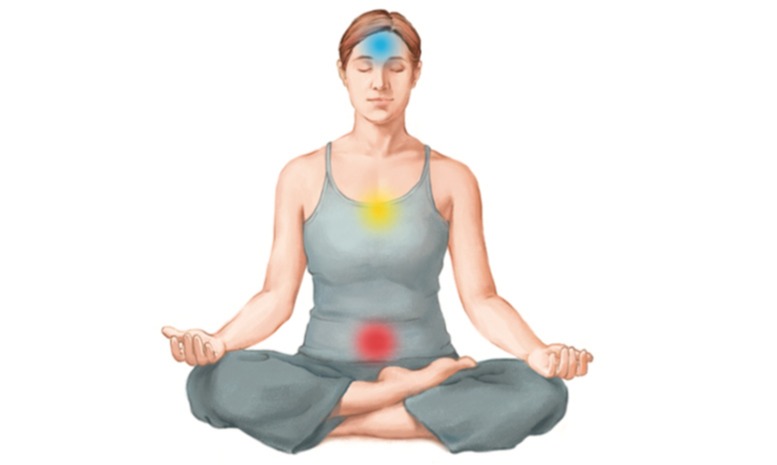The ancient sages of India developed a profound understanding of human existence that goes beyond the physical body. One of the most illuminating frameworks from yogic philosophy is the concept of the Three Bodies in Yoga or Trisharira. This model provides a layered understanding of the self, revealing how our experience of life is shaped not just by our physical presence but also by our mind and soul.
Table of Contents
The Three Bodies in Yoga:
Understanding these three bodies, Gross (Sthula), Subtle (Sukshma), and Causal (Karana) is essential for anyone walking the yogic path, as it forms the foundation for practices like pranayama, meditation, and self-inquiry (jnana yoga).
Sthula Sharira – The Gross Body:
The Sthula Sharira is the physical body, composed of flesh, bones, blood, organs, and skin. It is the body we can see, touch, and experience through the five senses.
- Made up of the five elements (Pancha Mahabhutas): Earth, Water, Fire, Air, and Ether
- Operates through gross senses and organs of action
Characteristics:
- Born from food (Annamaya Kosha – the food sheath)
- Subject to birth, growth, decay, and death
- Instrument for experiencing the external world
Related Yogic Practices:
- Asana (postures) for physical health and alignment
- Yogic diet and lifestyle (Ahimsa, Satvic foods)
- Karma Yoga- using the body in service
Sukshma Sharira – The Subtle Body:
The Sukshma Sharira or subtle body includes the mind, intellect, ego, and the vital energy (prana). It governs thoughts, emotions, desires, and internal functions like breathing, digestion, and circulation.
Composition:
- Pranamaya Kosha (energy body)
- Manomaya Kosha (mental body)
- Vijnanamaya Kosha (wisdom body)
Components:
- Prana (life-force energy)
- Mind (Manas)- seat of thoughts and emotions
- Intellect (Buddhi)- discrimination, decision-making
- Ego (Ahamkara)- sense of ‘I’ or individuality
- Five organs of perception + five of action + five vital airs
Characteristics:
- Invisible and subtle, it cannot be seen with the eyes
- Transmigrates from life to life (according to karma)
- Responsible for dream states, mental clarity, and emotional balance
Karana Sharira – The Causal Body:
The Karana Sharira is the causal body, the most subtle of the three. It is the seed or blueprint of the other two bodies and holds the impressions (samskaras) and latent tendencies (vasanas) that drive the soul’s journey across lifetimes.
Composition:
- Associated with the Anandamaya Kosha (the bliss sheath)
- Beyond mind and intellect, deeply unconscious
Characteristics:
- Root cause (Karana = cause) of the gross and subtle bodies
- Storehouse of karma and impressions from previous lives
- Experienced in deep sleep and Samadhi (non-dual absorption)
- Veils the true Self (Atman) with ignorance (Avidya)
Journey Through the Three Bodies:
| Body | State | Consciousness | Related Kosha |
|---|---|---|---|
| Gross Body | Waking (Jagrat) | Outward, sensory | Annamaya Kosha |
| Subtle Body | Dream (Svapna) | Mental, emotional | Pranamaya, Manomaya, Vijnanamaya |
| Causal Body | Deep Sleep (Sushupti) | Seed-like, latent | Anandamaya Kosha |
Beyond the Three Bodies – The Atman:
While the three bodies help us understand how we function, they are not the Self. Yoga teaches that behind all these layers is the Atman the pure, unchanging, eternal consciousness.
- Atman is sat-chit-ananda: Existence, Consciousness, and Bliss.
- It is not born, does not die, and is unaffected by the body, mind, or intellect.
- Realization of the Atman is the goal of all yoga.
Conclusion:
The concept of the Three Bodies in Yoga provides a roadmap for inner exploration. As practitioners progress through asana, pranayama, and meditation, they naturally begin to shift identification from the gross body to the subtle and finally toward the causal. Ultimately, yoga guides us to transcend all three and realize the timeless Self beyond body and mind.
By understanding and experiencing each layer, we begin to loosen the grip of ego and awaken to our true nature as pure awareness.
FAQ:
Q. What are the Three Bodies in Yoga?
A. The Three Bodies (Shariras) are:
- Sthula Sharira: The Gross (Physical) Body
- Sukshma Sharira: The Subtle (Energetic & Mental) Body
- Karana Sharira: The Causal (Seed/Bliss) Body
Together, they explain the structure of human experience from physical to spiritual levels.
Q. Is the soul (Atman) one of these bodies?
No. The Atman is beyond all three bodies. It is the true Self, pure consciousness, untouched by any body or experience. The three bodies are only vehicles through which the Self experiences the world.
Q. What happens to the three bodies after death?
- The Gross Body returns to the elements (earth, water, fire, air, ether).
- The Subtle Body and Causal Body move on with the soul and determine the next birth, based on karmic patterns.
- Only through liberation (moksha) are all three transcended.
Q. Can we experience the subtle and causal bodies?
A. Yes:
- Subtle Body is experienced in dreams, emotions, thoughts, and energy (like prana).
- Causal Body is glimpsed in deep sleep, Samadhi, or moments of profound stillness and bliss.
Q. What is the goal of understanding the Three Bodies?
A. The goal is Self-realization to go beyond identification with body and mind, and realize the Atman. Knowing these layers helps in:
- Detachment
- Deeper meditation
- Overcoming ego and suffering
Q. Do all yoga practices address all three bodies?
A. Yes, but in different ways:
- Asana: Works on the gross body
- Pranayama: Balances the subtle body
- Meditation & Self-inquiry: Penetrate the causal body
Q. What is the difference between the Subtle and Causal bodies?
A.
- The Subtle Body is active during dreams and waking thoughts.
- The Causal Body is dormant and experienced as deep unconsciousness or bliss; it’s the seed of all experiences and the subtlest form of individuality.
Q. Can liberation (moksha) be attained by working through the three bodies?
A. Yes. Yoga systematically:
- Purifies the Gross Body (via ethics, asana, diet)
- Balances the Subtle Body (via pranayama, mantra, meditation)
- Pierces the Causal Body (via deep meditation and inquiry)
When all identifications are dropped, the Atman is realized, and the cycle of rebirth ends.





